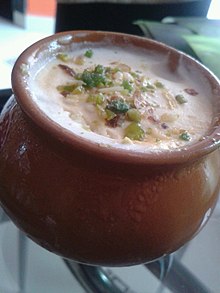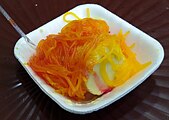South Asian frozen dessert
 Kulfi in a matka Kulfi in a matka | |
| Type | Ice cream |
|---|---|
| Course | Dessert |
| Region or state | South Asia Delhi |
| Associated cuisine | Pakistani Indian Bangladeshi |
| Main ingredients | Milk, sugar |
Kulfi (/kʊlfiː/) is a frozen dairy dessert from the Indian subcontinent. It is often described as "traditional Indian ice cream". Kulfi originated in 16th-century Delhi during the Mughal era. It is part of the national cuisines of India and Pakistan. It is also popular in Bangladesh, Myanmar, Nepal, Sri Lanka, and the Middle East.
Kulfi is denser and creamier than regular ice cream. It comes in various flavours. Traditional ones include cream (malai), rose, mango, cardamom (elaichi), saffron (kesar or zafran), and pistachio. Newer flavours may include apple, orange, strawberry, peanut, or avocado. Unlike ice cream, kulfi is not churned while it is frozen, resulting in a denser final product which is considered a distinct category of frozen dairy-based dessert. The density of kulfi causes it to melt more slowly than ice cream.
History
See also: Mughlai cuisineThe word kulfi comes from the Persian qulfi (قلفی) meaning "covered cup". The dessert originated in Delhi during the Mughal Empire in the 16th century. The mixture of dense evaporated milk was already popular in the sweet dishes in the Indian subcontinent. During the Mughal period, this mixture was flavoured with pistachios and saffron, packed into metal cones and immersed in slurry ice, resulting in the invention of kulfi. Ain-i-Akbari, a detailed record of the Mughal emperor Akbar's administration, mentions use of saltpeter for refrigeration as well as transportation of Himalayan ice to warmer areas.
Although Delhi has been described as the birthplace of kulfi, Australian food historian Charmaine O'Brien suggests, "...it is likely that originally evolved in the cooler climates of Persia or Samarkand and that the Mughals appropriated the concept and elaborated on it to create the creamy, perfumed dessert that it now is."
Preparation
To prepare kulfi, sweetened, flavoured milk is slow cooked. The milk is stirred almost continuously to prevent it from sticking to the cooking utensil. During this process, the milk condenses and thickens. The slow cooking caramelises the sugar in the mixture and browns its milk proteins, giving kulfi its distinctive taste. The mixture is then poured into moulds (often kulhars) and sealed. The sealed moulds are submerged in an insulated matka filled with ice and salt. This quickly freezes the mixture, giving it a soft, smooth consistency free of ice crystals. Kulfi prepared in this traditional way is called matka kulfi.
The moulds are removed from the freezer 10–15 minutes before serving to allow the kulfi to melt slightly. The kulfi is then removed from the moulds and garnished with ground cardamom, saffron, or pistachios. Kulfi is also served with falooda (vermicelli noodles).
Retail sales
Throughout the Indian subcontinent, kulfi is sold by street vendors known as kulfiwallahs. It is also commonly served in Indian restaurants.
Gallery
-
 Saffron- and mango-flavoured kulfi
Saffron- and mango-flavoured kulfi
-
Kulfi with strawberry sauce
-
 Pistachio-, vanilla-, and rose-flavoured kulfi
Pistachio-, vanilla-, and rose-flavoured kulfi
-
 Kulfi with falooda (vermicelli noodles)
Kulfi with falooda (vermicelli noodles)
-
 A vendor (kulfiwallah) selling kulfi in India
A vendor (kulfiwallah) selling kulfi in India
References
- ^ Michael Krondl (2011). Sweet Invention: A History of Dessert. Chicago Review Press. p. 48. ISBN 978-1-55652-954-2.
- ^ Charmaine O'Brien (2003). Flavours of Delhi: A Food Lover's Guide. Penguin Books Limited. p. 71. ISBN 9789351182375.
- ^ Caroline Liddell, Robin Weir (15 July 1996), Frozen Desserts: The Definitive Guide to Making Ice Creams, Ices, Complete Kulfi Recipes, Gelati, and Other Frozen Delights, Macmillan, 1996, ISBN 978-0-312-14343-5,
... Kulfi is the traditional Indian ice cream and has a strongly characteristic cooked-milk flavor and dense icy texture. ... The basis of making kulfi is to reduce a large volume of milk down to a very small concentrated amount ...
- ^ "50 Most Popular Indian Desserts to Add a Twist to Your Same Old Meal". 28 December 2020.
- ^ Matthew Kenney (September 2009), Entertaining in the Raw, Gibbs Smith, 2009, ISBN 978-1-4236-0208-8,
... Kulfi is an Indian-style ice cream that is richer and creamier than regular ice cream, due to the lack of air that is whipped into traditional ice cream to make it lighter. The milk, traditionally from buffalo ...
- ^ "An Illustrated Tour of Ice Cream Styles Around the World".
- "Ice, Cream... and Chemistry – American Chemical Society".
- ^ Anil K. Gupta; Anit Kumar; Megh R. Goyal (2018). Novel Dairy Processing Technologies: Techniques, Management, and Energy Conservation. Apple Academic Press. p. 78. ISBN 9781351682046.
- "Kulfi Glossary".
- "Effect of Different Level of Ash Gourd Pulp for Manufacturing Dietetic Kulfi" (PDF). Archived from the original (PDF) on 29 October 2021. Retrieved 29 October 2021.
- "Mango Kulfi -The Ultimate frozen summer dessert!". 28 June 2021.
- Charmaine O'Brien (2003). Flavours of Delhi: A Food Lover's Guide. Penguin Books Limited. p. 72. ISBN 9789351182375.
- Corby Kummer (2007). 1001 Foods To Die For. p. 784.
| Main and side dishes |
| ||||||
|---|---|---|---|---|---|---|---|
| Snacks and sauces | |||||||
| Breads | |||||||
| Beverages | |||||||
| Sweetmeats | |||||||
| Bangladeshi diaspora | |||||||
| Burmese cuisine | |
|---|---|
| Salads | |
| Rice dishes | |
| Noodle dishes | |
| Other dishes | |
| Snacks |
|
| Drinks and beverages | |
| Seasonings and ingredients | |
| Miscellaneous | |
| Ice cream | |
|---|---|
| Flavors |
|
| Forms | |
| Dishes |
|
| Events | |
| Lists | |
| Related | |
| Similar desserts | |